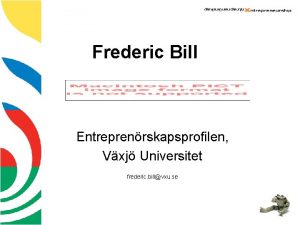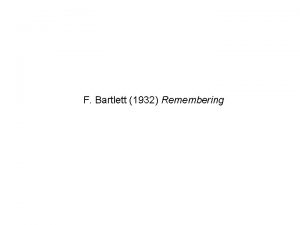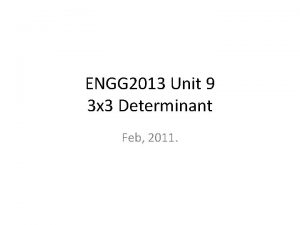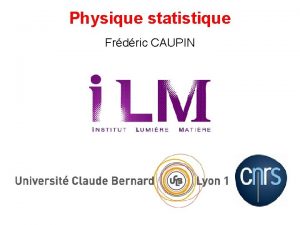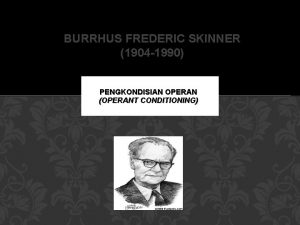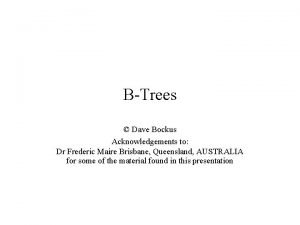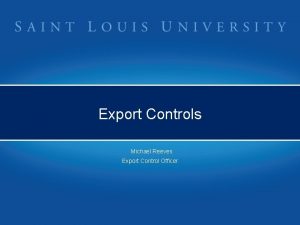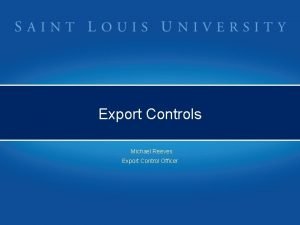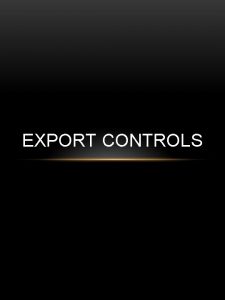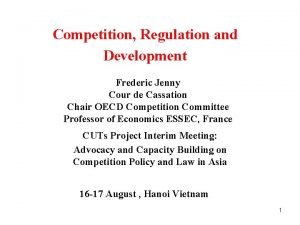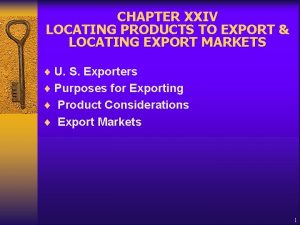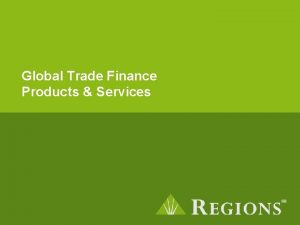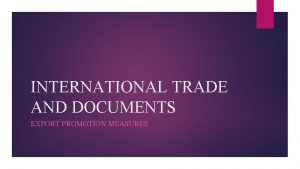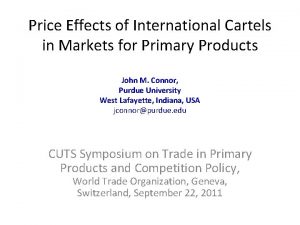International Export Cartels and Primary Products Frederic Jenny





![Alleged efficiency benefits of export cartels: an example [T]he appellants seek to place evidence Alleged efficiency benefits of export cartels: an example [T]he appellants seek to place evidence](https://slidetodoc.com/presentation_image_h/06f49d9b333e7fac9c69eeade76b2ef1/image-6.jpg)














- Slides: 20

International Export Cartels and Primary Products Frederic Jenny Professor of economics, ESSEC Business School Chairman, OECD Competition Committee CUTS Symposium on Trade in Primary Products and Competition Policy WTO, Geneva, September 22 2011

Different types of trans-border cartels 1) Pure private export cartel: a cartel composed of a group of producers within a single country whose collaborative conduct is directed solely at foreign markets ( ex: wood pulp, potash) 2) Mixed private export cartel: a national (single-country) cartel that has domestic as well as foreign commercial effects ( ex: EU coal) 3) Government directed or sponsored export cartels: a cartel between a group of firms within a single country which is either mandated or sponsored or supported by the government ( ex US soda ash, Chinese Vitamin C) 4) Private international export cartel : includes exporters from more than a single country; covers only exports ( ex: heavy electrical equipment from 1930 s to 1980 s) 5) Government directed or sponsored international cartel: an international cartel mandated or sponsored or supported by one or several governments (ex aluminium in the early 1990 s)

Explicit or implicit exemption from competition law in countries of exports Previous work identifies that 51 countries allow for export cartels either explicitly or implicitly in their antitrust regimes; this is approximately half of all countries with antitrust regimes. Seventeen countries, including the United States, maintain explicit exemptions. An additional thirty-four countries lack an explicit exemption. However, they maintain an implicit exemption because their domestic antitrust legislation limits the law’s reach to the domestic market. Margaret C. Levenstein & Valerie Y. Suslow, The Changing International Status of Export Cartels, 20 AM. U. INT’L L. REV. 785, 800 (2005). ) D. Daniel Sokol, What do we really know about export cartels and what is the appropriate solution ? , University of Florida Legal Studies Research Paper No. 2009 -05

Exemption for export cartels in developing countries Section 3(b)(i) of the 1998 South African Competition Act lists “maintenance or promotion of exports” as one of the possible grounds for granting an exemption for a restrictive agreement or practice. Section 5(ii) of India’s 2002 Competition Act is a more far-reaching ‘carve-out’: “Nothing in this section [on anti- competitive agreements] shall restrict … the right of any person to export goods from India to the extent to which the agreement relates exclusively to the production, supply, distribution or control of goods or provision of services for such export. ” In China, agreements that “ safeguard the legitimate interest in foreign trade and economic cooperation may be exempted. The availability of exemption does not require proof that such arrangements will not substantially restrict competition and that consumers will be able to share in the benefits of the agreements.

Why are export cartels treated more leniently than international cartels ? If a cartel takes on an international as opposed to purely national character, the justification for antitrust abstention becomes less clear. First, a cartel with multinational membership is likely to impose greater damage on the importing state, strengthening that state's interest in taking whatever countermeasures it can. Second, arguments based on the right of a state to nationalize its own industries and on the foreign compulsion defense become more difficult, for trans-border nationalizations and compulsion orders are politically difficult and rare in practice. Thus, an international export cartel should not expect the same deference from U. S. or other antitrust authorities. Atwood, 50 Law & Contemp. Probs. 153 1987
![Alleged efficiency benefits of export cartels an example The appellants seek to place evidence Alleged efficiency benefits of export cartels: an example [T]he appellants seek to place evidence](https://slidetodoc.com/presentation_image_h/06f49d9b333e7fac9c69eeade76b2ef1/image-6.jpg)
Alleged efficiency benefits of export cartels: an example [T]he appellants seek to place evidence before the Tribunal to show that Ansac is a legitimate joint venture whose purpose it is to pool costs and resources so as to make it possible for them to trade competitively within exports markets where there are barriers to entry and significant risks. They seek to demonstrate that by virtue of pooling costs and resources Ansac has been able to appoint independent sales and distribution staff dedicated solely to sales and services of customers, has been able to negotiate and obtain decreased freight and stevedoring charges and has entered into a variety of costreducing overseas warehousing and distribution agreements. The result of this is that Ansac has achieved reductions in marketing and distribution costs and can undertake competitive sales to new countries and overseas markets including those with high logistical and political risks and offer customers worldwide the enhanced reliability and efficiency made possible by increased volumes and the back-up supply commitments of US soda ash producers. (Para 27) 1) March 2001, South Africa Competition Appeals Tribunal Judgment on Ansac vs Botash 49/CR/Apr 00

What is Potash? Potash (K 2 O) originates from the element potassium (K). Small amounts of potassium are needed to support many of the crucial enzyme processes in plants and play a vital role in the transport of sugars and other products of photosynthesis from leaves to storage organs. An adequate quantity of potassium is essential for crops to achieve full potential yield. In times of environmental stress such as drought or frost, potash allows the plant to have a higher tolerance to these physiological conditions. Potash fertilizers include potash sulphate and potash magnesia sulphate. Potash is used for all crops, however mainly used in the assistance of growing fruits, vegetables, soybeans, alfalfa, cabbage, and corn.

International potash exports

Potash consumption and production in different countries

The Canadian potash export cartel Canada owns 52% of the world known reserves of potash while Russia and Belarus own 30%. The three largest producers of Potash in Canada, Potash. corp, Mosaic and Agrium with a total share of 35% of the world market participate in a cartel, called Canpotex, which manages their worldwide sales (with the exception of their exports to the United States for fear of US antitrust laws). The cartelists coordinate their production to maintain a high level of price. The producers from Russia and Belarus have created their own cartel which coordinates with Canpotex. Together the two cartels control about 70% of the world exports of Potash.

Potash consumption in India ‘s demand for fertilizers and, in particular for potash, is fast increasing because of its goal of achieving self sufficiency in food while its population is rapidly increasing and the scope of increasing its land area under cultivation is limited. India must increase its foodgrain production by about 45% by 2025 which requires a significant increase of agricultural productivity and a more intensive use of fertilizers. India which does not have potash deposits imported over 5 million tons in 2009 at a cost of US $2. 5 billion.

The potash price In an environment historically characterized by long-term contracts, available excess capacity, and a limited number of sellers, potash prices were low and stayed within a limited range of between $125 and $200 per K 2 O tonne (price at the Saskatchewan mine gate) for a period of nearly 20 years, starting in the mid-1980 s. However, gradual improvements in demand, accompanied by almost no supply increases, resulted in a tightening of the supply/demand balance for potash. That led to an improvement in potash prices in the mid-part of the past decade, which culminated in a potash price spike in late 2008 and early 2009. The end result is that the mine gate price in Saskatchewan averaged $825 per K 2 O tonne in 2009. After reaching that peak, prices fell considerably in response to a collapse in demand in 2009. PCS (in concert with Mosaic Co. and Agrium Inc. ) significantly reduced volumes to stabilize prices. In 2009, PCS took its utilization level well below 50 per cent in order to shore up prices.

The battle for potash

Expected prices of potash under a competitive scenario and a cartel scenario Price 2011 2012 2013 2014 2015 2016 2017 2018 2019 2020 Competitive Scenario 574 356 245 226 217 488 Cartel Scenario 574 591 601 611 734 $US per ton

What does this mean for China ? On average under the current cartel scenario the price of potash would be doubled or $321 more expensive per ton than under the competitive scenario from 2011 to 2020 If we assume that China needs to import an average of 5 million tons of potash per year between 2011 and 2020, which is an estimate based on the imports in 2010, the surcharge it will pay on average each year will be 182 US$ per ton (and therefore 182 x 5. 000= US$ 910. 000 per year) if it succeeds in getting an 18% discount from the cartel price (as it did in 2011), and could reach US $ 1. 6 billion annually.

What does this mean for India ? If we assume that India needs an average of 6. 5 million tons of potash per year between 2011 and 2020, the overcharge it will pay each year will be on average US $ 1. 2 billion, if it succeeds in getting an 18% discount (as China), and could reach $ 1. 6 billion toward 2020 when the pressure of demand will be greatest. Thus, if the Indian government keeps on paying an annual subsidy of $1. 5 billion to make potash fertilizers more affordable for Indian farmers, from 80% to 100% of this subsidy will in fact finance the monopolistic rent that potash producers will enjoy on their sales to India thanks to the restrictive practices of Canpotex.

China may start cartel investigation into iron ore giants China is considering initiating a cartel investigation into the big three iron ore giants, BHP Billion Ltd. , Vale SA and Rio Tinto Group, the Chinese press has reported. The Chinese state authorities are currently researching the issue of price manipulation by the three companies in the context of the sensitive annual iron ore talks, Chinese press reports have said, adding that it will soon be revealed whether the country will start an investigation. As Steel. Orbis previously reported, the Chinese steel industry has been outraged by the massive iron ore price increases of more than 90 percent in quarterly contracts which are being sought by the iron ore industry. The European Commission has also been approached by the European steel industry to investigate the seaborne iron ore market. Steel. Orbis Thursday, April 15, 2010

Policy options about export cartels -Differentiated treatment of private and government sponsored export cartels ? - Private export cartels - Partial or total repeal of explicit or implict exemptions from competition laws ? (Trebilcock, Guzman, Becker national treatment principle, useof GATT article III: 4) -Plurilateral or multilateral agreement on tranparency (Sokol) and cooperation on competition with respect to export cartels (Levenstein and Suslow for joint monitoring) ?

Policy options about export cartels Government sponsored export cartels -Total ban on government sponsored export cartels in developed countries (Hoekman and Mavroidis, Singh)? -Partial ban on government sponsored export cartels (Scherer) ? - Balancing of interest (Atwood) - Creation in the WTO of a reverse antidumping style remedy where the export price exceeds the normal value

Thank you very much for your attention Frederic. jenny@gmail. com
 Cartel de tijuana
Cartel de tijuana China international import export 2019
China international import export 2019 Functional vs innovative products
Functional vs innovative products Pepsi 4ps marketing mix
Pepsi 4ps marketing mix Ethical assessment screen
Ethical assessment screen Sejarah tes minat
Sejarah tes minat Yvonne blue
Yvonne blue Frederic bill
Frederic bill Schema bartlett
Schema bartlett Determinant formula
Determinant formula Frederic mars
Frederic mars A caixa de skinner
A caixa de skinner Frédéric caupin
Frédéric caupin Frederic chopin accomplishments
Frederic chopin accomplishments Burrhus frederic skinner (1904-1990)
Burrhus frederic skinner (1904-1990) Frederic sutter
Frederic sutter The father of scientific management
The father of scientific management Frederic tomas
Frederic tomas Frederic malherbe
Frederic malherbe Paul frederic simon
Paul frederic simon Frederic maire
Frederic maire







